2013 TOYOTA AURIS HYBRID lights
[x] Cancel search: lightsPage 610 of 768
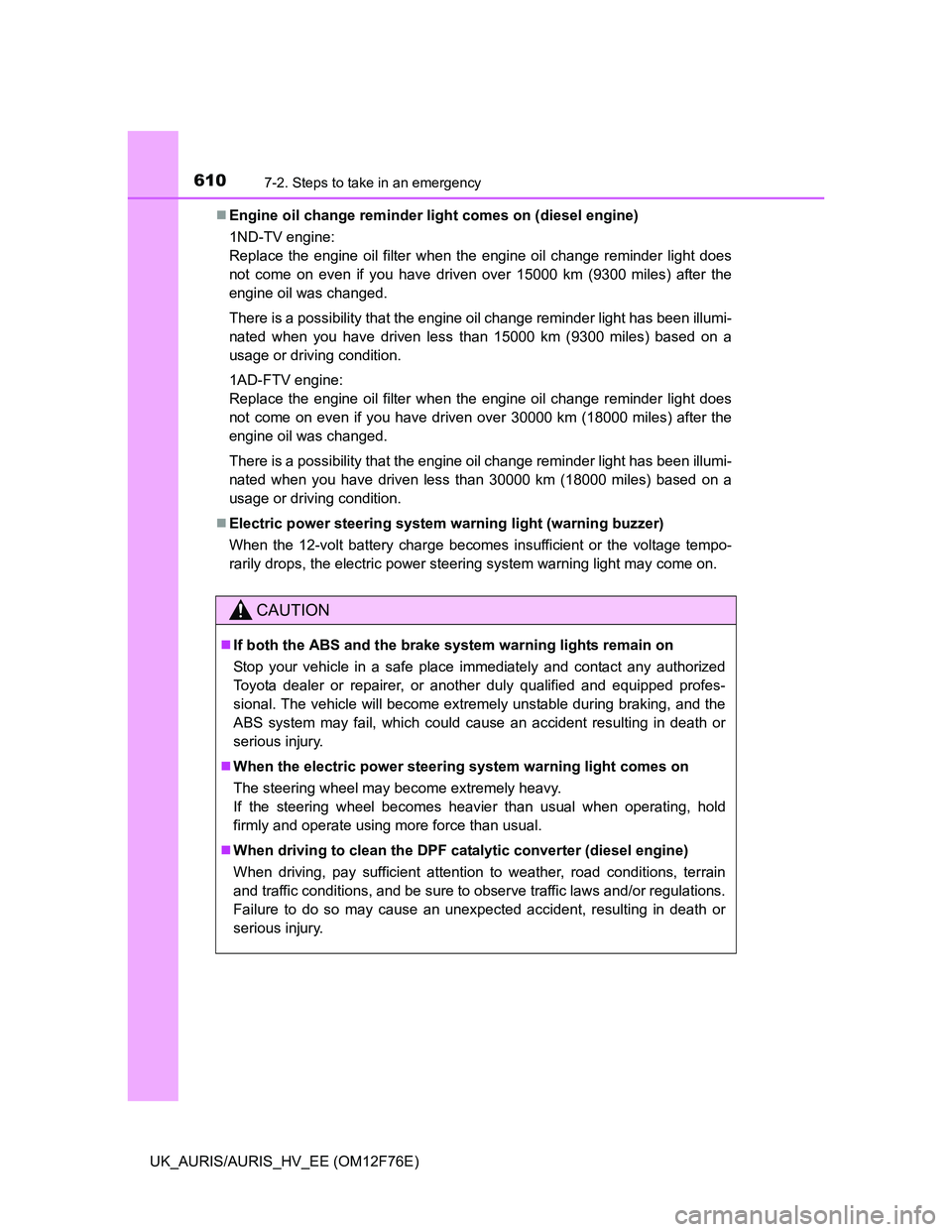
6107-2. Steps to take in an emergency
UK_AURIS/AURIS_HV_EE (OM12F76E)Engine oil change reminder light comes on (diesel engine)
1ND-TV engine:
Replace the engine oil filter when the engine oil change reminder light does
not come on even if you have driven over 15000 km (9300 miles) after the
engine oil was changed.
There is a possibility that the engine oil change reminder light has been illumi-
nated when you have driven less than 15000 km (9300 miles) based on a
usage or driving condition.
1AD-FTV engine:
Replace the engine oil filter when the engine oil change reminder light does
not come on even if you have driven over 30000 km (18000 miles) after the
engine oil was changed.
There is a possibility that the engine oil change reminder light has been illumi-
nated when you have driven less than 30000 km (18000 miles) based on a
usage or driving condition.
Electric power steering system warning light (warning buzzer)
When the 12-volt battery charge becomes insufficient or the voltage tempo-
rarily drops, the electric power steering system warning light may come on.
CAUTION
If both the ABS and the brake system warning lights remain on
Stop your vehicle in a safe place immediately and contact any authorized
Toyota dealer or repairer, or another duly qualified and equipped profes-
sional. The vehicle will become extremely unstable during braking, and the
ABS system may fail, which could cause an accident resulting in death or
serious injury.
When the electric power steering system warning light comes on
The steering wheel may become extremely heavy.
If the steering wheel becomes heavier than usual when operating, hold
firmly and operate using more force than usual.
When driving to clean the DPF catalytic converter (diesel engine)
When driving, pay sufficient attention to weather, road conditions, terrain
and traffic conditions, and be sure to observe traffic laws and/or regulations.
Failure to do so may cause an unexpected accident, resulting in death or
serious injury.
Page 616 of 768
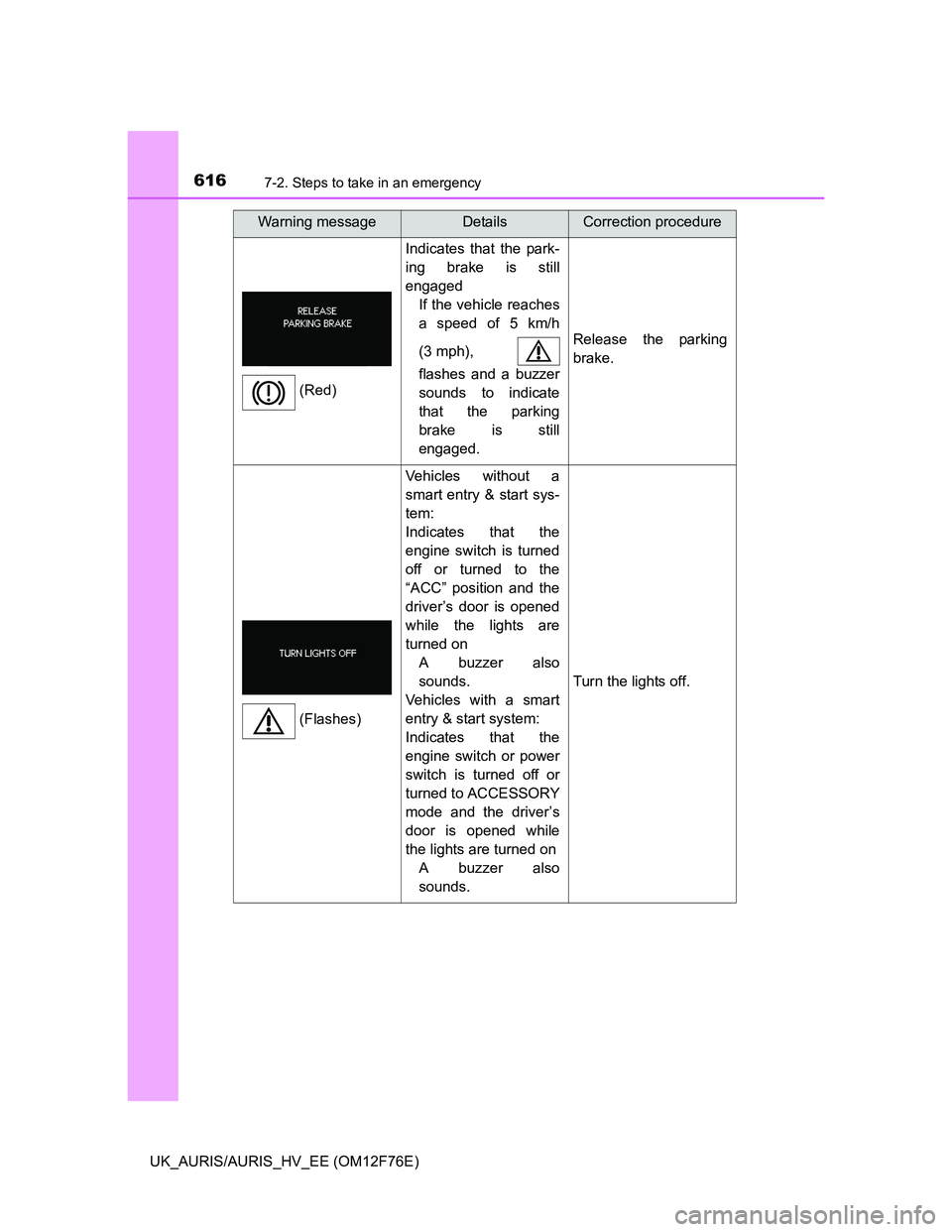
6167-2. Steps to take in an emergency
UK_AURIS/AURIS_HV_EE (OM12F76E)
Indicates that the park-
ing brake is still
engaged
If the vehicle reaches
a speed of 5 km/h
(3 mph),
flashes and a buzzer
sounds to indicate
that the parking
brake is still
engaged.
Release the parking
brake.
Vehicles without a
smart entry & start sys-
tem:
Indicates that the
engine switch is turned
off or turned to the
“ACC” position and the
driver’s door is opened
while the lights are
turned on
A buzzer also
sounds.
Vehicles with a smart
entry & start system:
Indicates that the
engine switch or power
switch is turned off or
turned to ACCESSORY
mode and the driver’s
door is opened while
the lights are turned on
A buzzer also
sounds.
Turn the lights off.
Warning messageDetailsCorrection procedure
(Red)
(Flashes)
Page 678 of 768
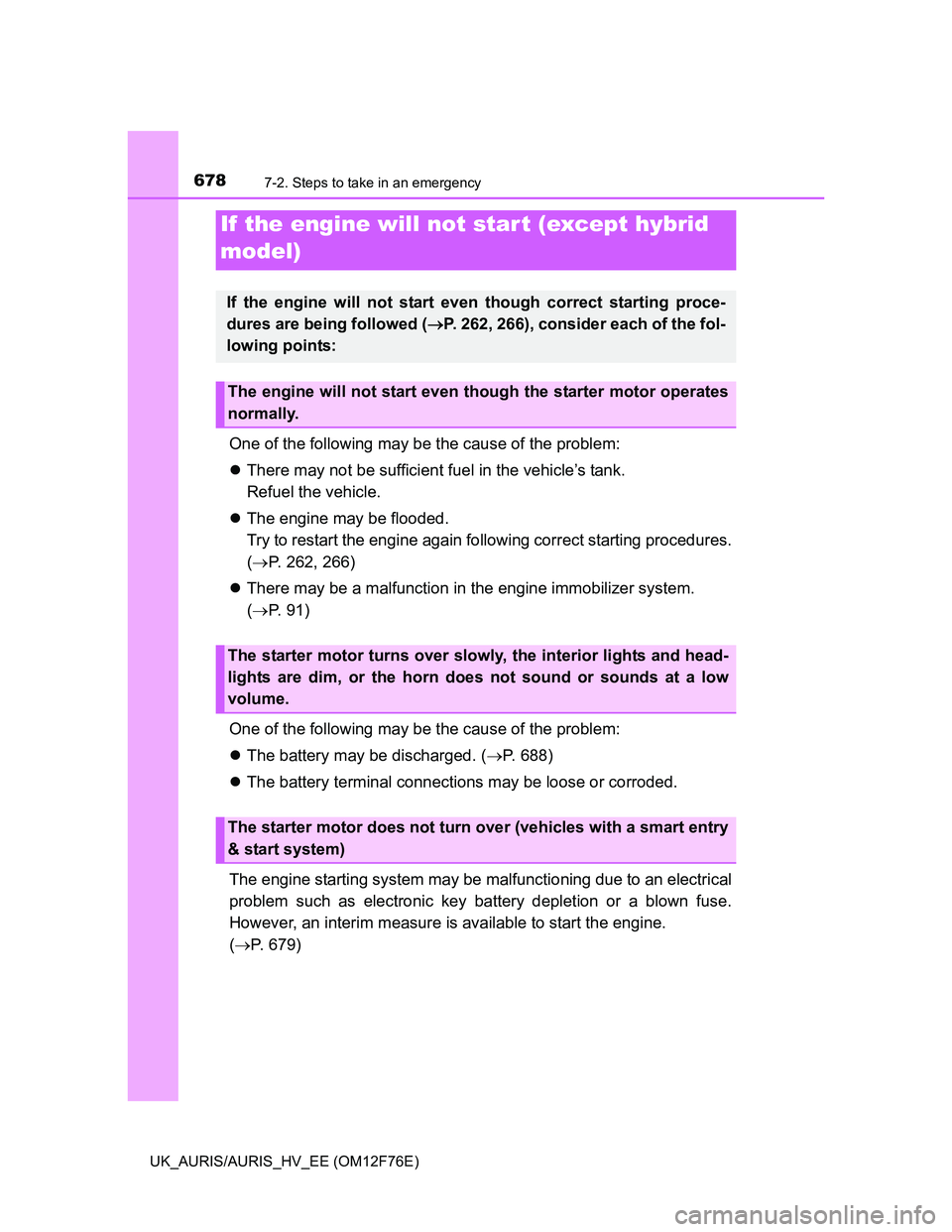
6787-2. Steps to take in an emergency
UK_AURIS/AURIS_HV_EE (OM12F76E)
One of the following may be the cause of the problem:
There may not be sufficient fuel in the vehicle’s tank.
Refuel the vehicle.
The engine may be flooded.
Try to restart the engine again following correct starting procedures.
(P. 262, 266)
There may be a malfunction in the engine immobilizer system.
(P. 91)
One of the following may be the cause of the problem:
The battery may be discharged. (P. 688)
The battery terminal connections may be loose or corroded.
The engine starting system may be malfunctioning due to an electrical
problem such as electronic key battery depletion or a blown fuse.
However, an interim measure is available to start the engine.
(P. 679)
If the engine will not start (except hybrid
model)
If the engine will not start even though correct starting proce-
dures are being followed (P. 262, 266), consider each of the fol-
lowing points:
The engine will not start even though the starter motor operates
normally.
The starter motor turns over slowly, the interior lights and head-
lights are dim, or the horn does not sound or sounds at a low
volume.
The starter motor does not turn over (vehicles with a smart entry
& start system)
Page 679 of 768

6797-2. Steps to take in an emergency
UK_AURIS/AURIS_HV_EE (OM12F76E)
7
When trouble arises
One of the following may be the cause of the problem:
One or both of the battery terminals may be disconnected.
The battery may be discharged. (P. 688)
There may be a malfunction in the steering lock system.
Contact any authorized Toyota dealer or repairer, or another duly qualified
and equipped professional if the problem cannot be repaired, or if repair
procedures are unknown.
When the engine does not start, the following steps can be used as an
interim measure to start the engine if the engine switch is functioning
normally:
Shift the shift lever to P (Multidrive) or N (multi-mode manual trans-
mission or manual transmission).
Set the parking brake.
Turn the engine switch to ACCESSORY mode.
Press and hold the engine switch for about 15 seconds while
depressing the brake pedal (Multidrive or multi-mode manual trans-
mission) or clutch pedal (manual transmission) firmly.
Even if the engine can be started using the above steps, the system
may be malfunctioning. Have the vehicle inspected by any authorized
Toyota dealer or repairer, or another duly qualified and equipped pro-
fessional.
The starter motor does not turn over, the interior lights and head-
lights do not turn on, or the horn does not sound.
Emergency start function (vehicles with a smart entry & start
system)
1
2
3
4
Page 680 of 768
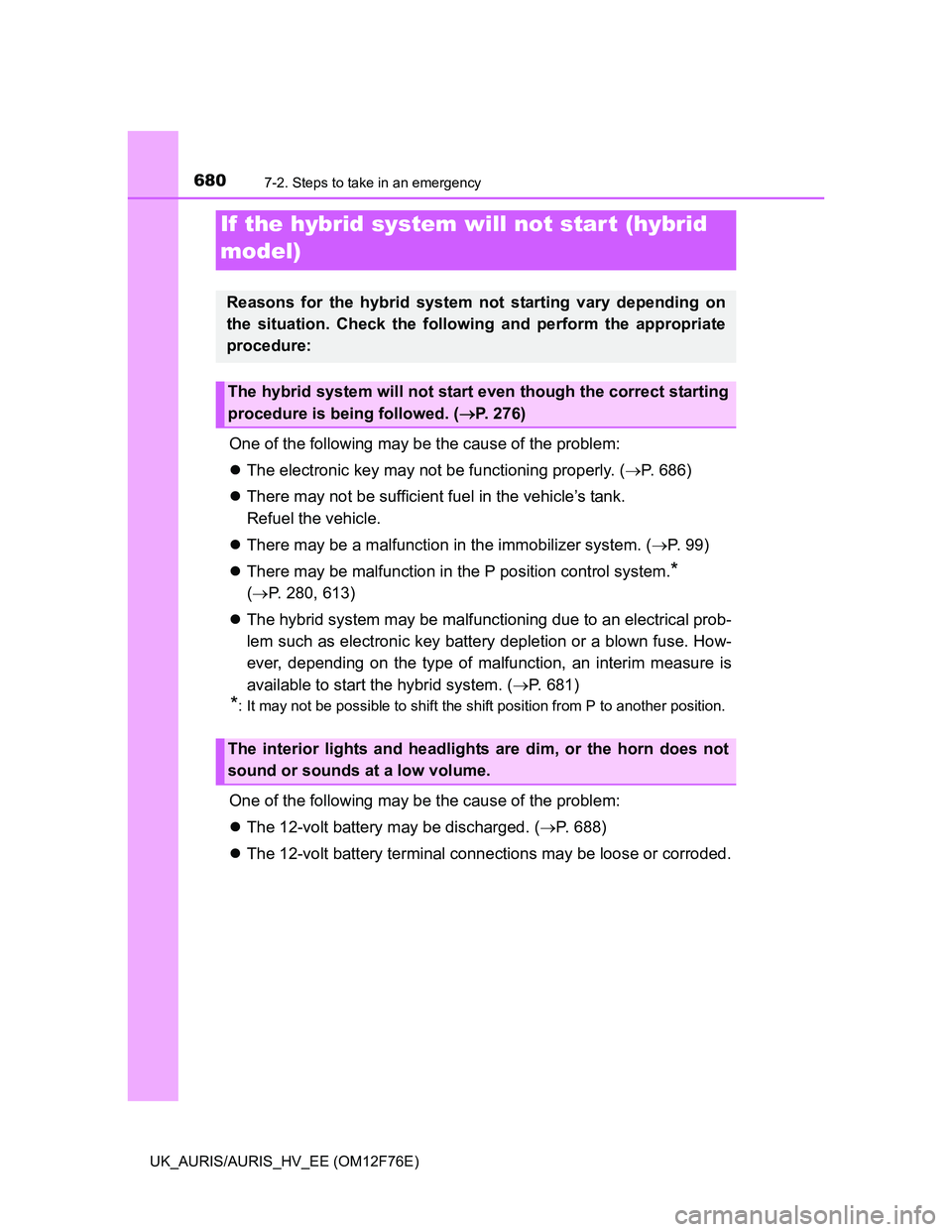
6807-2. Steps to take in an emergency
UK_AURIS/AURIS_HV_EE (OM12F76E)
One of the following may be the cause of the problem:
The electronic key may not be functioning properly. (P. 686)
There may not be sufficient fuel in the vehicle’s tank.
Refuel the vehicle.
There may be a malfunction in the immobilizer system. (P. 9 9 )
There may be malfunction in the P position control system.
*
(P. 280, 613)
The hybrid system may be malfunctioning due to an electrical prob-
lem such as electronic key battery depletion or a blown fuse. How-
ever, depending on the type of malfunction, an interim measure is
available to start the hybrid system. (P. 681)
*: It may not be possible to shift the shift position from P to another position.
One of the following may be the cause of the problem:
The 12-volt battery may be discharged. (P. 688)
The 12-volt battery terminal connections may be loose or corroded.
If the hybrid system will not star t (hybrid
model)
Reasons for the hybrid system not starting vary depending on
the situation. Check the following and perform the appropriate
procedure:
The hybrid system will not start even though the correct starting
procedure is being followed. (P. 276)
The interior lights and headlights are dim, or the horn does not
sound or sounds at a low volume.
Page 681 of 768
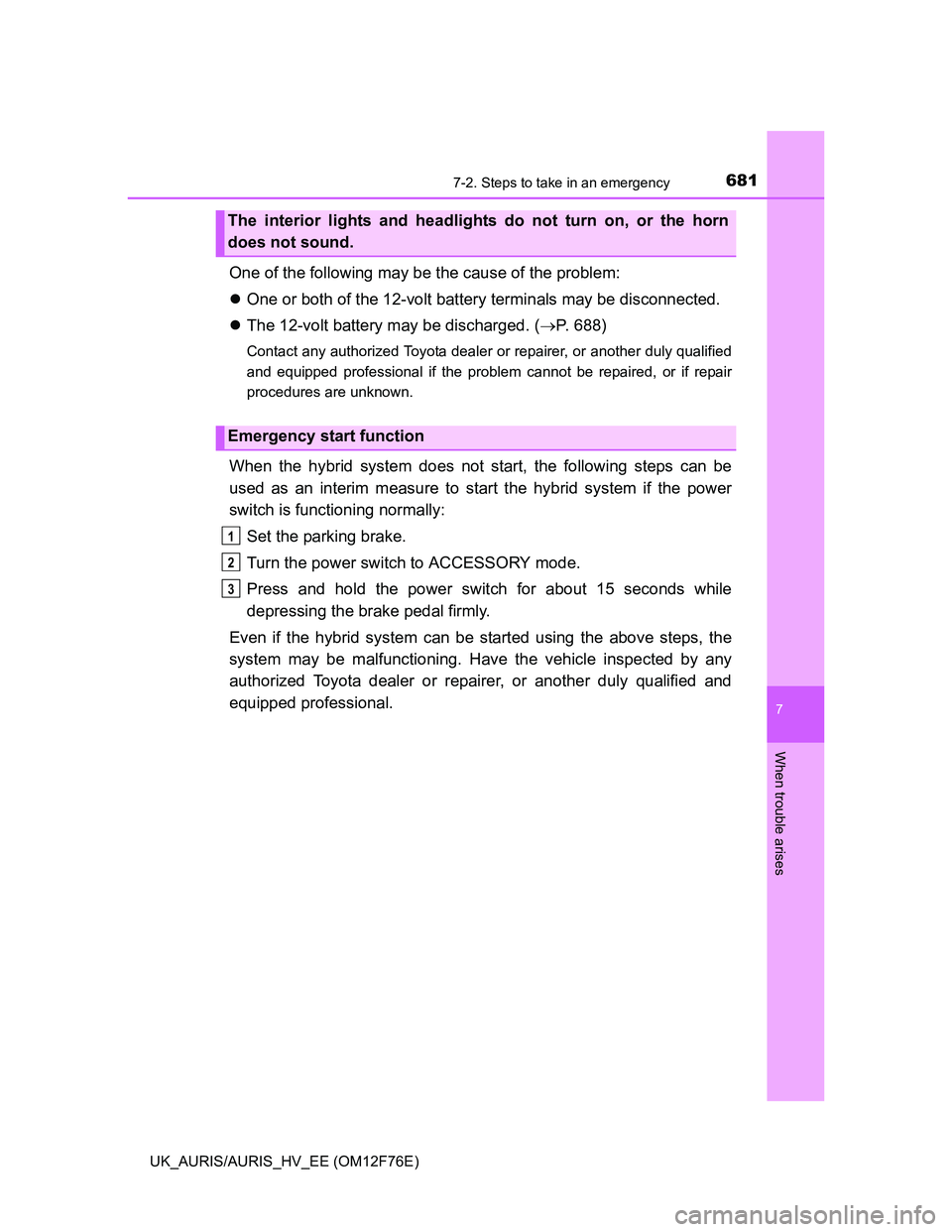
6817-2. Steps to take in an emergency
UK_AURIS/AURIS_HV_EE (OM12F76E)
7
When trouble arises
One of the following may be the cause of the problem:
One or both of the 12-volt battery terminals may be disconnected.
The 12-volt battery may be discharged. (P. 688)
Contact any authorized Toyota dealer or repairer, or another duly qualified
and equipped professional if the problem cannot be repaired, or if repair
procedures are unknown.
When the hybrid system does not start, the following steps can be
used as an interim measure to start the hybrid system if the power
switch is functioning normally:
Set the parking brake.
Turn the power switch to ACCESSORY mode.
Press and hold the power switch for about 15 seconds while
depressing the brake pedal firmly.
Even if the hybrid system can be started using the above steps, the
system may be malfunctioning. Have the vehicle inspected by any
authorized Toyota dealer or repairer, or another duly qualified and
equipped professional.
The interior lights and headlights do not turn on, or the horn
does not sound.
Emergency start function
1
2
3
Page 692 of 768
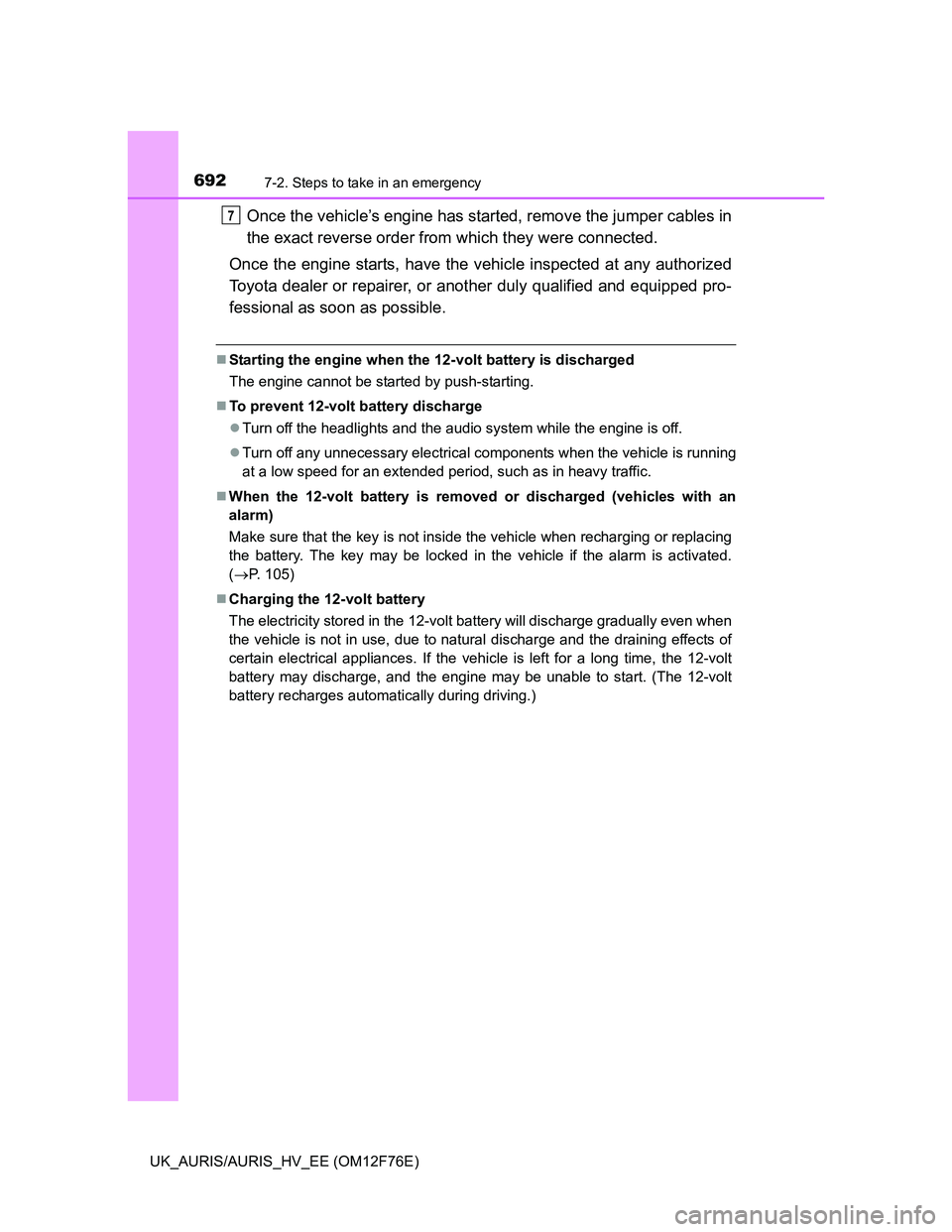
6927-2. Steps to take in an emergency
UK_AURIS/AURIS_HV_EE (OM12F76E)
Once the vehicle’s engine has started, remove the jumper cables in
the exact reverse order from which they were connected.
Once the engine starts, have the vehicle inspected at any authorized
Toyota dealer or repairer, or another duly qualified and equipped pro-
fessional as soon as possible.
Starting the engine when the 12-volt battery is discharged
The engine cannot be started by push-starting.
To prevent 12-volt battery discharge
Turn off the headlights and the audio system while the engine is off.
Turn off any unnecessary electrical components when the vehicle is running
at a low speed for an extended period, such as in heavy traffic.
When the 12-volt battery is removed or discharged (vehicles with an
alarm)
Make sure that the key is not inside the vehicle when recharging or replacing
the battery. The key may be locked in the vehicle if the alarm is activated.
(P. 105)
Charging the 12-volt battery
The electricity stored in the 12-volt battery will discharge gradually even when
the vehicle is not in use, due to natural discharge and the draining effects of
certain electrical appliances. If the vehicle is left for a long time, the 12-volt
battery may discharge, and the engine may be unable to start. (The 12-volt
battery recharges automatically during driving.)
7
Page 697 of 768

6977-2. Steps to take in an emergency
UK_AURIS/AURIS_HV_EE (OM12F76E)
7
When trouble arises
Once the hybrid system has started, remove the jumper cables in
the exact reverse order from which they were connected.
Close the exclusive jump starting terminal cover, and reinstall the
fuse box cover to its original position.
When installing, first hook the fuse box cover onto the two rear tabs.
Once the hybrid system starts, have the vehicle inspected at any
authorized Toyota dealer or repairer, or another duly qualified and
equipped professional as soon as possible.
Starting the hybrid system when the 12-volt battery is discharged
The hybrid system cannot be started by push-starting.
To prevent 12-volt battery discharge
Turn off the headlights and the audio system while the hybrid system is off.
Turn off any unnecessary electrical components when the vehicle is running
at a low speed for an extended period, such as in heavy traffic.
When the 12-volt battery is removed or discharged
The hybrid system may not start. (P. 528)
If the 12-volt battery is depleted with the shift position in P, it will not be pos-
sible to shift the shift position other than P. In this case, the vehicle cannot
be towed without lifting both front wheels because the front wheels are
locked by the parking lock. (P. 587)
When the 12-volt battery is reconnected, start the hybrid system, depress
the brake pedal, and confirm that it is possible to shift into each shift posi-
tion.
Vehicles with an alarm: Make sure that the key is not inside the vehicle
when recharging or replacing the 12-volt battery. The key may be locked in
the vehicle if the alarm is activated. (P. 105)
Charging the 12-volt battery
The electricity stored in the 12-volt battery will discharge gradually even when
the vehicle is not in use, due to natural discharge and the draining effects of
certain electrical appliances. If the vehicle is left for a long time, the 12-volt
battery may discharge, and the hybrid system may be unable to start. (The
12-volt battery recharges automatically while the hybrid system is operating.)
8
9